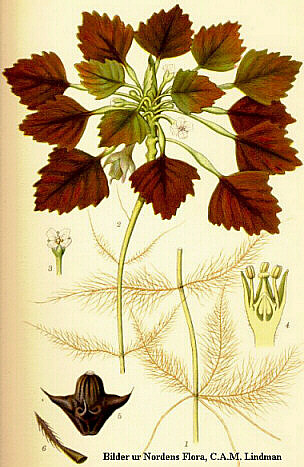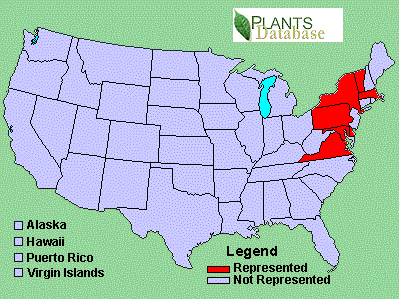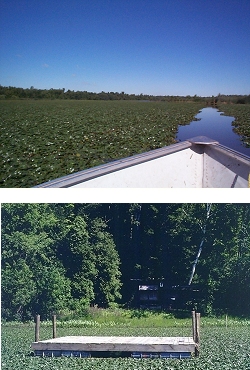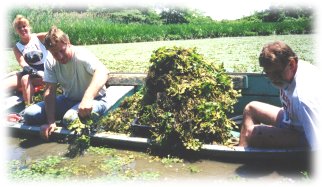
Scientific Name:Trapa natans L.
Classification:
Phylum or Division: Magnoliophyta
Class: Magnoliopsida
Order: Myrtales
Family: Trapaceae
Identification: The water chestnut is an
annual aquatic plant whose leaves
occur both above and below water. The leaves that float above water are
triangular and have saw-like, toothed edges. They are shiny on the
topside and
dull with fine hairs on the underside. The petioles on the surface
leaves have
large bulbous sections called air bladders. The leaves form a rosette
on the
surface and can be up to a foot in diameter. The submersed leaves are
divided into
segments that are whorled around the stem and are feather-like. Amongst
the surface leaves are small white
flowers that extend from the axils. The fruit is a large (2.5
cm), woody, nut that has usually four, but sometimes two sharp, barbed
points
and contains a single fleshy seed. Each rosette can produce as many as
10-15
of these seeds. The plant stems are long and cord-like and can grow up
to 16 feet in order
for the plant to become rooted.
Original Distribution: The water
chestnut is a native of the warm temperate regions of Europe and Asia
and tropical
Africa. In
Africa it is native to countries such as Algeria, Tunisia, Sudan,
Tanzania, Uganda, Guinea-Bissau, Angola, Malawi, Mozambique, Zambia,
Zimbabwe, Botswana, Namibia, and South Africa. In Asia Trapa natans
is native to Turkey, Georgia, China, Japan, India, Pakistan, and
Vietnam.
Finally, the countries where it can be found in Europe include Austria,
Czechoslovakia, Germany, Hungary, Poland, Switzerland, Belarus,
Ukraine,
Albania, Bulgaria, Greece, Italy, Romania, Yugoslavia, France, and
Spain.
Current
Distribution: Currently the water
chestnut can be found in New York,
Delaware, Maryland, Massachusetts, New
Hampshire, Pennsylvania, Vermont,
Virginia, and Washington D.C. It is also found in the Great Lakes Basin
and
Quebec, Canada. It can also be found as a nonnative in Europe, the
Caucusus (Chechnya), and
Siberia. Water chestnut was once found in localities in Holland,
Belgium, and
Sweden but has since vanished.
Massachusetts, New
Hampshire, Pennsylvania, Vermont,
Virginia, and Washington D.C. It is also found in the Great Lakes Basin
and
Quebec, Canada. It can also be found as a nonnative in Europe, the
Caucusus (Chechnya), and
Siberia. Water chestnut was once found in localities in Holland,
Belgium, and
Sweden but has since vanished.
Site and Date of
Introduction: The introduction of water
chestnut is believed to have happened in 1859 at the
Cambridge Botanical Garden in Cambridge, Massachusetts, however there
are conflicting reports. More generally it is
accepted that it entered the U.S. somewhere in the northeast in the
1850s. The
first observed case of water chestnut in New York was in 1884, in
Sanders Lake,
in Schenectady. From there it was able to spread, through
interconnected
waterways, to Massachusetts and Vermont. It was first reported in the
southern
part of Vermont’s Lake Champlain in the 1940’s. Eventually, water
chestnut made
its way into Canada and was found in South River, in Quebec in 1998.
Mode(s) of Introduction: The water chestnut was intentionally introduced into several ponds at the Cambridge Botanical Garden in Cambridge, Massachusetts by a gardener. It was also planted, again intentionally, in a pond in Concord, Massachusetts next to the Sudbury River. The plants aesthetic appeal was the reason for this intentional introduction. It was then introduced into other areas via interconnected waterways. The seeds were able to disperse into distant rivers and lakes by animals who unknowingly carried them while foraging, including Canada Geese. They can also become attached to mammal fur, human clothing, nets, wooden boats, construction equipment, and other vehicles aiding in their dispersal.
Reason(s) Why it has Become
Established: Although it is difficult
to pinpoint characteristics that
make a species successful at becoming established there is one that can
be
agreed upon by all. The repeated introduction of a species into an area
increases the likelihood that the species will become established. When
water
chestnut was first introduced into the U.S. it was as an ornamental.
Humans
were trying to help it become established for a specific reason. Any
species
that is cultivated by humans, whether it is agricultural or ornamental,
will
have a greater chance of becoming established solely because we want it
to
happen. In addition there are no native predators here in the U.S. to
control the population growth. The native waterfowl find
water chestnut to have no nutritional value and therefore do not feed
on it letting it grow unabated.
One seed can produce 10-15 rosettes with each rosette producing 15-20
seeds.
These seeds then have the ability to remain viable for up to 12 years
because
of their protective coating. The combination of a large number of seeds
and
their extreme hardiness helps the water chestnut to become established.
The
rosettes can also break off from the plant and survive on their own.
They then
float with the current and get dispersed long distances. This adds to
the
number of dispersal methods for the plant again increasing its chances
to
establish itself.
Ecological Role: In its native habitat
water chestnut is cultivated and eaten by native people. However, in
its
new habitat water chestnut plays a totally different role. First, it
directly
competes with native submerged aquatic vegetation for resources by
growing in
dense patches and crowding out these native species. These dense
patches are
also a hindrance to navigation in the waterways. The plant itself has
very
little nutritional value and cannot be eaten by native waterfowl.
Because of
this lack of nutritional value it has no native predators. In its
native
habitat there are predators that are closely associated with the water
chestnut. The
leaf beetle, G.
birmanica, defoliates most of the plants, causing the mats of
plants to
sink. Chironomid midges are also frequently associated with the plants,
but
for the most part are only filter feeders, not herbivores. By cleaning
the leaf
they may allow increased light absorption and gas exchange, helping the
plant to grow. The Italian weevil, Bagous rufimanus, feeds
within the fruit stems and might be
more
damaging at higher than observed population levels. However, these
species are
not found in their new habitat. There are some species that do
associate with
water chestnut here in its new habitat. Among these species are
duckweeds and
filamentous algae that grow among the rosettes. Here they can take
advantage of
the shelter provided from the wind and currents. Because of its
decomposition
and the large quantity of detritus that is produced water chestnut
plays a role in altering
the oxygen levels in the water. This will then have negative impacts on
 fish populations
and other plants in the area.
fish populations
and other plants in the area.
Benefit(s): Because of their high
densities, water chestnut may play a
role in water purification. The high density of these plants slows down
water
currents allowing for deposition of sediment and removal of nutrients.
A study
by Tsuchiya and Iwakuma (1993) has shown that water chestnut removes
nitrogen
from runoff, preventing the eutrophication of water downstream. They
have also
shown the ability to accumulate heavy metals. Since most animals do not
eat the
water chestnut, it would effectively remove the heavy metals from the
water
where they could be potentially hazardous to other plants and fish. Not
only can
the plants improve water quality, but they also provide some utility
for
wildlife. Water chestnut can provide a habitat for invertebrates. These
invertebrates then become a major food source for fish. Birds can also
use the
water chestnut beds to forage on. They can walk out on the beds and eat
the
insects associated with the plant. Norway rats, eastern chipmunks, and
gray and
red squirrels also eat the nuts. In its native India the water chestnut
is
valued for its nutritional and medicinal values, used to treat
illnesses from
rabies to diarrhea. There are also other possible ways to exploit water
chestnut including for paper pulp, fertilizer, fish food, compost, and
biogas fuel.
Threat(s): The ability of water
chestnut to cover nearly all the water
surface at times causes it to block 95% of the sunlight from
penetrating the
water. This affects the plants underneath by shading them out and not
allowing
them to grow. By replacing these native plants, there is a subsequent
loss
of many animal species that depend on these native plants to survive.
Eventually there is a loss in local biodiversity making the area
susceptible to
other invasions and extinctinons due to stochastic events. Epiphyton,
including algae,
cyanobacteria, and macroinvertebrates have been shown to favor the
submersed
vegetation as opposed to water chestnut which floats on the surface.
Since the
water chestnut crowds out this submersed vegetation there is a decrease
in
epiphyton, which is a major food source for epiphytic fauna, which is
then a food source for fish
and waterfowl. Not only does the crowding affect the populations of
other
plants, but also the water chestnut alters the dissolved oxygen content
of the
water, which has an impact on plant growth. The crowding of the plants
decreases the dissolved oxygen content making it more difficult for
plants to
survive. Water chestnut has the ability to survive in these anoxic
conditions,
however most plants do not. The decrease in dissolved oxygen content
and plant
and macroinvertabrate levels could also lead to fish kills. The water
chestnut
also threatens recreational use of the waterways. Boats get tangled up
in the
dense mats and damage their engines, while preventing them from
navigating the
waters. Sport hunting and fishing is also declining in these areas
because the
populations of waterfowl and fish are declining due to loss of native
plant
species. Organic waste also builds up in the dense mats leading to
water
pollution and breeding grounds for mosquitoes.
Control Level Diagnosis: “Highest Priority” – Measures to control the water chestnut should be addressed immediately. Plant populations are growing very rapidly and ecosystem destruction is already being seen. The longer we wait the more time and money it will take to control their populations. The time to act is now.
Control Method: There are
many ways that have been attempted to control water chestnut. The major
methods
are chemical, physical, and biological control. There are also attempts
being
made through the use of legislation and education. The use of
herbicides in the
Mohawk River, the Hudson River, and Lake Champlain have been effective
in
reducing the population density, however many native plant species are
also
susceptible to these chemicals. Herbicides, such as
2,4-dicholorophenoxy acetic acid (2,4 D), have
been known to also have harmful side effects on fish populations. This
control
method is seen as less expensive than physical methods, however there
are some trade offs with the hazards. There are two types of
physical control methods being employed, mechanical and hand harvesting. The
plants can either be cut out by machines or pulled out by hand. These
methods
are best used before the mature fruits begin to drop. It is critical to
remove
the whole plant so that fragments are not left behind to reproduce.
This makes
these efforts time consuming and costly. Biological control has also
been
looked at. In the early 1990s research was being done to find a native
predator. The beetle Galerucella
birmanica,
has been
known to eat up to 40% of the leaf tissue, but was also found to have
detrimental effects on other plants. Other insects were found to eat
the plant
but were not damaging enough. Predators that are found in India have
potential
but would not survive the cooler climate in the northeast U.S. Grass
carp is
another species with potential, however it does not solely feed on
water
chestnut and might damage native plant populations. Water chestnut has
also
been found to be susceptible to pathogenic fungus. One such fungus was
cultured
from a plant in the Watervliet Resevoir and could be used for control
purposes.
In addition to the many present and potential methods, the control of
water
chestnut can be supplemented with legislation and education. Presently
35
states have designated water chestnut as a noxious weed. By doing this
they
make it illegal to propagate, sell or transport the weed. A combination
of
these many methods might be the best way to control this problem.
harvesting. The
plants can either be cut out by machines or pulled out by hand. These
methods
are best used before the mature fruits begin to drop. It is critical to
remove
the whole plant so that fragments are not left behind to reproduce.
This makes
these efforts time consuming and costly. Biological control has also
been
looked at. In the early 1990s research was being done to find a native
predator. The beetle Galerucella
birmanica,
has been
known to eat up to 40% of the leaf tissue, but was also found to have
detrimental effects on other plants. Other insects were found to eat
the plant
but were not damaging enough. Predators that are found in India have
potential
but would not survive the cooler climate in the northeast U.S. Grass
carp is
another species with potential, however it does not solely feed on
water
chestnut and might damage native plant populations. Water chestnut has
also
been found to be susceptible to pathogenic fungus. One such fungus was
cultured
from a plant in the Watervliet Resevoir and could be used for control
purposes.
In addition to the many present and potential methods, the control of
water
chestnut can be supplemented with legislation and education. Presently
35
states have designated water chestnut as a noxious weed. By doing this
they
make it illegal to propagate, sell or transport the weed. A combination
of
these many methods might be the best way to control this problem.
References:
1. Caraco,
N., Cole, J. 2002. Contrasting impacts of a native and alien macrophyte
on
dissolved oxygen in a large river. Ecological Applications.
12(5):1496-1509.
2.
Groth, A., Lovett-Doust, L., Lovett-Doust, J. 1996. Population Density
and Module
Demography in Trapa natans (Trapaceae), an annual, clonal, aquatic
macrophyte. American Journal of Botany. 83(11): 1406-1415.3.
3.
Hummel, M., Kiviat, E. 2004. Review of World Literature on Water
Chestnut with
Implications for Management in North America. Journal of Aquatic Plant
Management. 42: 17-28.
4.
Les, D., Mehrhoff, L. 1999. Introduction of nonindigenous aquatic
vascular plants in
southern New England: a historical perspective. Biological Invasions
1(2 and 3): 281–300.
5.
Maryland Department of Natural Resources. 2004. Water Chestnut.
Retrieved on October 27, 2004 from
<http://www.dnr.state.md.us/bay/sav/water_chestnut.html>
6.
Menegus, F., Cattaruzza, L., Scaglioni, L., Ragg, E. 1992. Effects of
oxygen level on
metabolism and development of seedlings of Trapa natans and two
ecologically related species.Physiologia Plantarum. 86(1):168-172.
7.
Methe, B., Soracco, R. J., Madsen, J. D., Boylen, C. W. 1993. Seed
production and
growth of waterchestnut as influenced by cutting. Journal of Aquatic
Plant Management. 31(JAN. SPEC. ED.):154-157.
8.
Naylor, M. 2003. Water Chestnut (Trapa natans) in the Chesapeake Bay
Watershed: A Regional Management Plan. Maryland Department of Natural
Resources.
9.
Vermont Department of Environmental Conservation. 2004. Water Quality
Division.
Water Chestnut. Retrieved on October 27, 2004 from
<http://www.anr.state.vt.us/dec/waterq/lakes/htm/ans/lp_wc.htm>
10.
Pemberton, R. 1999. Natural enemies of Trapa spp. in Northeast Asia and
Europe.
Biological Control. 14(3):168-180.
11.
Titus, J. 1994. Submersed plant invasions and declines in New York.
Lake & Reservoir Management. 10(1):25-28.
Photo Credits:
1. Diagram of water chestnut taken from http://www.iisgcp.org/EXOTICSP/waterchestnut.htm
Credit: Lindman.
2. Range map provided by Plants Database and taken from http://www.iisgcp.org/EXOTICSP/waterchestnut.htm
3. Picture showing spread of water chestnut across a lake taken from http://www.anr.state.vt.us/dec/waterq/lakes/htm/ans/lp_wc.htm
4. Picture of removal of water chestnuts taken from http://www.dnr.state.md.us/bay/sav/water_chestnut.html